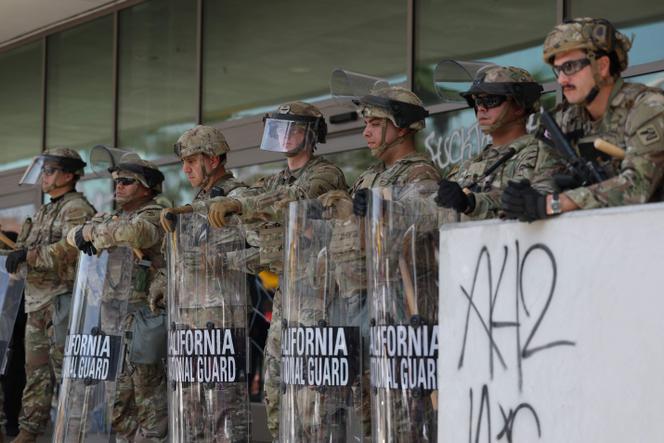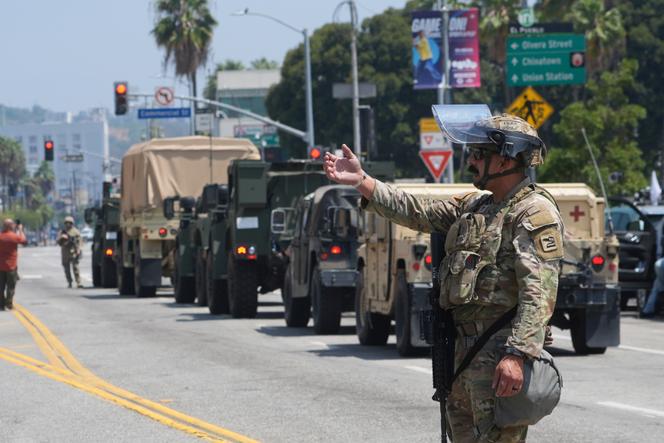


California Governor Gavin Newsom filed an emergency request in federal court on Tuesday, June 10 to block the Trump administration from using the National Guard and Marines to assist with immigration raids in Los Angeles. Newsom's move comes after President Donald Trump ordered the deployment of roughly 4,000 National Guard members and 700 Marines to Los Angles following four days of protests driven by anger over the president's stepped-up enforcement of immigration laws. The governor's request said it was in response to a change in orders for the Guard.
The filing included a declaration from Paul Eck, deputy general counsel in the California Military Department. Eck said the department has been informed that the Pentagon plans to direct the California National Guard to start providing support for immigration operations. That support would include holding secure perimeters around areas where raids are taking place and securing streets for immigration agents.
The Guard members were originally deployed to protect federal buildings. It was not clear if the change in mission had begun. Newsom's office did not immediately say how the state was notified about the change.

In other developments Tuesday, the Marine Corps commandant said the Marines that deployed to the Los Angeles area on Trump's orders have not yet been called to respond to the protests and are there only to protect federal officials and property. The 700 Marines and another 2,000 National Guard troops were ordered to LA on Monday, escalating a military presence that local officials and Gov. Gavin Newsom do not want and that the police chief says makes it harder to handle the protests safely.
Marine Corps Gen. Eric Smith told a budget hearing on Capitol Hill that the battalion has not yet been sent to any protests. The Marines were trained for crowd control but have no arrest authority and are there to protect government property and personnel, he said.
Trump left open the possibility of invoking the Insurrection Act, which authorizes the president to deploy military forces inside the US to suppress rebellion or domestic violence or to enforce the law in certain situations. It's one of the most extreme emergency powers available to a US president.
"If there's an insurrection, I would certainly invoke it. We'll see," he said Tuesday from the Oval Office. "But I can tell you last night was terrible, and the night before that was terrible."
Trump has described Los Angeles in dire terms that Mayor Karen Bass and Newsom say are nowhere close to the truth. While protesters blocked a major freeway and set cars on fire over the weekend, the demonstrations in the city of 4 million people have largely been centered in several blocks of downtown. On Monday, they were far less raucous, with thousands of people peacefully attending a rally at City Hall and hundreds more protesting outside a federal complex that includes a detention center where some immigrants are being held following workplace raids across the city.
At daybreak on Tuesday, guard troops were stationed outside the detention center, but there was no sign of the Marines. Obscene slogans directed at Trump and federal law enforcement remained scrawled across several buildings. At the Walt Disney Concert Hall, workers were busy washing away graffiti on Tuesday morning. In nearby Santa Ana, armored guard vehicles blocked a road leading to federal immigration and government offices. Workers swept up plastic bottles and broken glass near buildings sprayed with graffiti.
Sending in the military is the latest step in the administration's immigration crackdown as Trump pursues the mass deportations he promised last year during the presidential campaign. The protests have been driven by anger over the stepped-up enforcement that critics say is breaking apart migrant families.
Defense Secretary Pete Hegseth suggested Tuesday that the use of troops inside the US will continue to expand.
"I think we're entering another phase, especially under President Trump with his focus on the homeland, where the National Guard and Reserves become a critical component of how we secure that homeland," he said on Capitol Hill.
The mayor and the governor say Trump is putting public safety at risk by adding military personnel, even though police say they don't need the help. Los Angeles Police Chief Jim McDonnell said he was confident in the police department's ability to handle large-scale demonstrations and that the Marines' arrival without coordinating with the police department would present a "significant logistical and operational challenge."
Newsom, in a post on X, called the deployments reckless. "This isn't about public safety," the governor said. "It's about stroking a dangerous President's ego."
Protests spread across the U.S. The protests began Friday after federal immigration authorities arrested more than 40 people across Los Angeles and continued over the weekend as crowds blocked a major freeway and set self-driving cars on fire. Police responded with tear gas, rubber bullets and flash-bang grenades. Demonstrations spread Monday to other cities nationwide, including San Francisco and Santa Ana, California, as well as Dallas and Austin, Texas. Authorities in Austin said police used pepper spray balls and tear gas to disperse a crowd that threw rocks and bottles at officers, injuring four.
Meanwhile, the Pentagon said deploying the National Guard and Marines costs $134 million. That figure came out Tuesday just after Hegseth engaged in a testy back-and-forth about the costs during a congressional hearing. The defense secretary said the department has a budget increase and the money to cover the costs, and he defended Trump's decision to send the troops, saying they are needed to protect federal agents doing their jobs.
The last time the National Guard was activated without a governor's permission was in 1965, when President Lyndon B. Johnson sent troops to protect a civil rights march in Alabama, according to the Brennan Center for Justice.
